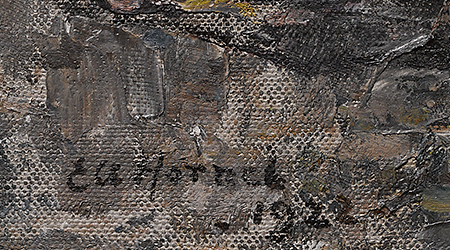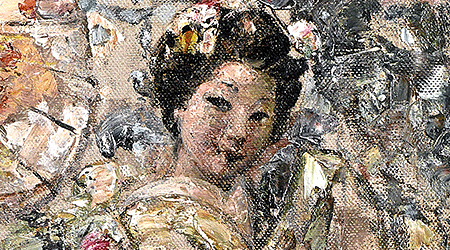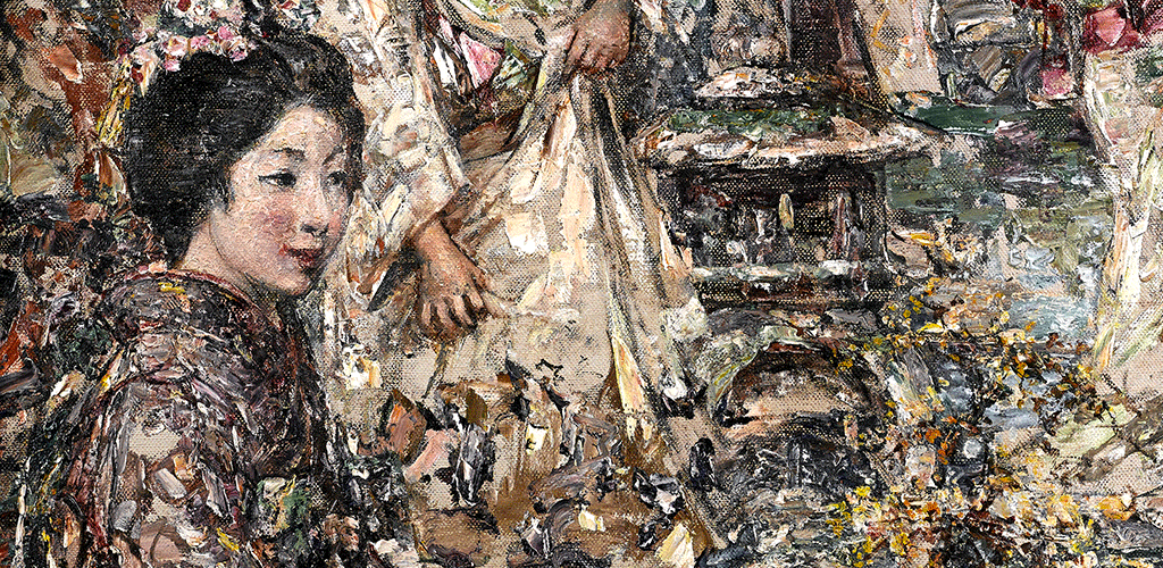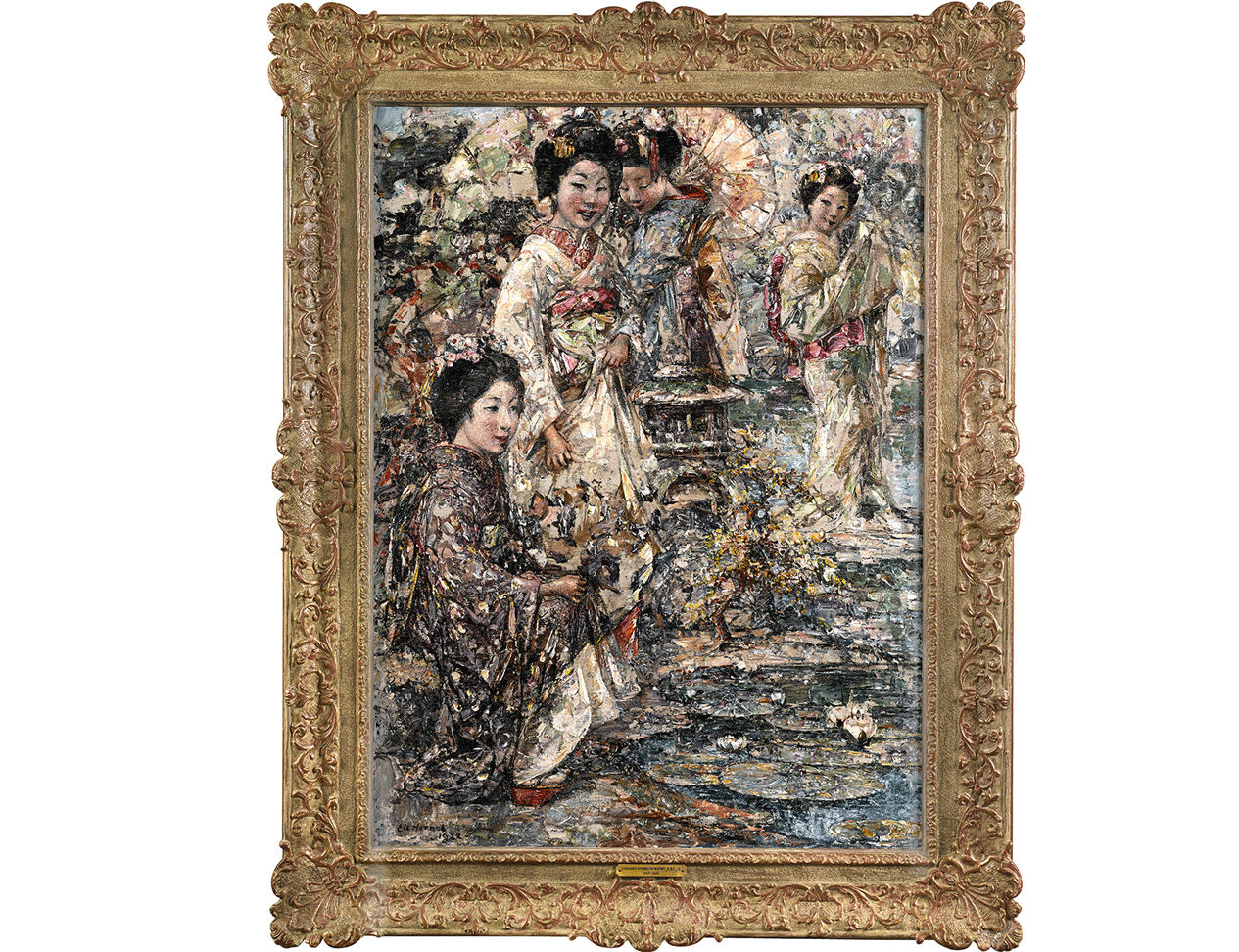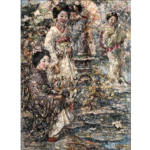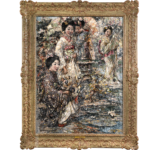Japanese art and culture were steadily drawn to the British public’s attention through a series of exhibitions in the latter half of the nineteenth century. The result was a flourishing Japonisme – a taste for things Japanese – and it was under this prevailing mood that Hornel and his friend George Henry set forth to Japan in 1893, ‘to see and study the environment out of which this great art sprung, to become personally in touch with the people, to live their life, and discover the source of their inspiration‘ (E.A. Hornel quoted in B. Smith, Hornel, Edinburgh, 1997, p. 89). The thirteen month trip had a great impact upon Hornel’s artistic career. On his return to Scotland, he exhibited his Japanese paintings at Alex Reid’s gallery in Glasgow to high critical acclaim, with audiences captivated by his dazzling portrayal of Japanese life. Hornel’s experience of Japan provided him with an ongoing source of inspiration.
To him the Japanese aesthetic was ‘the greatest impressionism the world has so far possessed – all useless details are laid aside‘, ‘whereas we have been working too much on the surface, and in striving to realise Truth have forgotten the spirit‘ (Hornel’s 1895 lecture ‘Japan’, Corporation Art Galleries, Glasgow, 9 February 1895, transcript from Broughton House).
He revisited the subject throughout his career, forever enchanted by the tea ceremonies, the beautiful dancing, the elegance of the young women and their vibrant costumes. The decorative splashes of colour he employs display the influence of Japanese art, but the formal approach to composition is largely his own. He uses more intense, mosaic-like brushwork and colour, which highlights the influence of late Pre-Raphaelitism, Dante Gabriel Rossetti, and more specifically of the French painter Adolphe Monticelli (1824-1886). The Japanese Garden reveals Hornel’s enthusiasm for Japanese culture, while the energetic surface, the dynamic postures and expressive faces of the geishas reflect Hornel’s driving interest in rendering life and movement in his art.
Edward Atkinson Hornel was born in 1864 in Australia but was brought up and lived in Scotland. In 1880, he started his formal studies in art at the Trustees Academy in Edinburgh. Three years later he enrolled to study at the Royal Academy of Fine Arts in Antwerp, an experience which immersed him in the avant-garde ideas engaging the continent during the period.
Hornel exhibited for the first time in 1883 at the Edinburgh Exhibition. Later, he became a member of the International Society of Painters and Engravers and an associate member of the New Gallery. In 1901, Hornel was elected to the Royal Scottish Academy but declined the honour.
Hornel was one of the leading figures of the Glasgow School, an informal alliance of some twenty artists that came together in the early 1880s known to introduce forms of Impressionism to Scotland. Inspired by contemporary French painting and Japanese prints, the Glasgow Boys produced their most notable works between the 1890’s and 1910. They used realism and naturalism to move away from Victorian sentimentality in painting. They are now recognised as having revolutionised Scottish painting and paved the way for a new ‘modern’ style of painting that swept Europe and America.
Over the years, Hornel closely collaborated with the painter George Henry. The two worked side by side for about ten years having produced a series of pictures that are regarded as the essence of the Glasgow School. Through this friendship, Hornel moved to a more colourful, decorative and increasingly symbolic style. In 1893–94, the two artists spent a year and a half in Japan. Hornel became fascinated with the beauty of Japanese culture. Influenced by Oriental art, Hornel developed a decorative approach, sometimes bordering on the abstract and inspired in part by Whistler’s progressive art.
